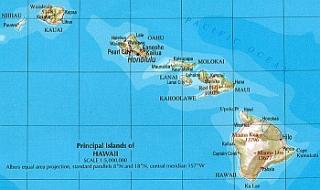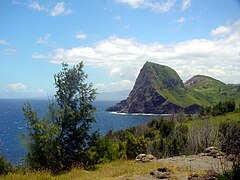
Exploring the history and experiences of mixed heritage persons and inter-racial relationships across the world

Exploring the history and experiences of mixed heritage persons and inter-racial relationships across the world
 The northernmost of the Polynesian islands, Hawaii is one of the states of the United States of America. The hundreds of islands are spread over some 2,400kms and its near central position in the relatively calm Pacific Ocean means that it has been the destination of many immigrants from the Americas and Asia. Hawaii was never a colony as such. Up to the overthrow of the monarchy in 1893, through a period of independence as a republic and right up to annexation in 1898, it remained an independent nation.
The northernmost of the Polynesian islands, Hawaii is one of the states of the United States of America. The hundreds of islands are spread over some 2,400kms and its near central position in the relatively calm Pacific Ocean means that it has been the destination of many immigrants from the Americas and Asia. Hawaii was never a colony as such. Up to the overthrow of the monarchy in 1893, through a period of independence as a republic and right up to annexation in 1898, it remained an independent nation.
The islands are said to have been first populated as early as 300BC by Polynesian migrants from the Marquesas and later on from Raiatea and Bora Bora. British explorer, James Cook, has the dubious honour of being the first recorded European contact, naming the islands Sandwich Islands in honour of the sponsor of his trip. His illustrious exploring career ended on his second trip to the islands when he died with 4 others in a fight with the big island king in 1779. European contact also meant contact with the ‘old world’ diseases of such as small pox, scarlet fever, typhoid fever and tuberculosis which soon decimated the local population. Measles killed a fifth of Hawaii's people during the 1850s.
 The 2008 American Community Survey conducted by the U.S. Census Bureau estimated that non-Hispanic Asian Americans made up 37.6% of the population. The first recorded Asian contribution to Tahiti’s large American Asian population are the Chinese, the first of these said to have been aboard Captain Cook’s ships with further influxes coming in from Guangdong province in and around the 1780s. In 1885, the first wave of Japanese labourers arrived to man the sugar cane and pineapple plantations. The Koreans arrived in two batches, the 1st in the early 1900s and another wave around 1965. Filipinos, many agricultural labourers and the majority male, immigrated primarily to Hawaii and California after the Spanish-American War when the Philippines also became an overseas territory of the USA. Additionally after the Second World War, laws were passed in the US that allowed veterans to collect their Filipino wives and children which resulted in some 16,000 war brides moving to the USA. The Filipinos are the largest Asian group numbering about 175,000 and followed by about 161,000 Japanese Americans.
The 2008 American Community Survey conducted by the U.S. Census Bureau estimated that non-Hispanic Asian Americans made up 37.6% of the population. The first recorded Asian contribution to Tahiti’s large American Asian population are the Chinese, the first of these said to have been aboard Captain Cook’s ships with further influxes coming in from Guangdong province in and around the 1780s. In 1885, the first wave of Japanese labourers arrived to man the sugar cane and pineapple plantations. The Koreans arrived in two batches, the 1st in the early 1900s and another wave around 1965. Filipinos, many agricultural labourers and the majority male, immigrated primarily to Hawaii and California after the Spanish-American War when the Philippines also became an overseas territory of the USA. Additionally after the Second World War, laws were passed in the US that allowed veterans to collect their Filipino wives and children which resulted in some 16,000 war brides moving to the USA. The Filipinos are the largest Asian group numbering about 175,000 and followed by about 161,000 Japanese Americans.
Latin Americans form another large distinct part of the Hawaiian population with the 1st of these arriving from Puerto Rico after their local sugar industry there was devastated by hurricanes in 1899. The powerful Hawaiian plantation owners with other key capitalists used the islands ‘territorial’ status to recruit ‘cheap’ labour from Puerto Rico and Mexico, a practice prohibited in many states within the USA. It took 60 years before Hawaii became a fully-fledged state in 1959. In the 2008 American Community Survey, Hispanics and Latinos made up 8.7% of the islands’ population.
The 1900 census showed the islands after years of decline had only 40,000 ‘native’ Hawaiians but the decline was reversed and in the 2000 census they numbered approximately 400,000. According to some sources only 1 in 50 ‘natives’ are in fact ‘full blood’, many having some European and even Asian ancestry. Like their Tahitian cousins, native seems to be defined by culture rather than by race. Thoroughbred Tahitians will cease to exist by 2050.
Since the early 20th century, Hawaii is a majority-minority state meaning Non-Hispanic whites do not form a majority only making up only 24.8% of the population.
Mixed-race individuals form roughly 21% of the population with the Eurasian Americans forming the largest contingent numbering over 60,000 individuals. According to the state Health Department, nearly one-third of marriages in the islands are between interracial couples. When ethnicities rather than race are taken into account, more than half of the marriages are mixed. This trend will explain the 30% rise in mixed race people in the 10 years from 2000. Hawaiians use the term ‘hapa’ for mixed race individuals of Hawaiian ancestry. Usually the word is qualified with a second term to describe the mix for example ‘hapa kolea’ for those who are part Korean. When used without the additional ethnic descriptor, hapa is often taken to mean part European, the full term ‘hapa haole’.
According to the state Health Department, nearly one-third of marriages in the islands are between interracial couples. When ethnicities rather than race are taken into account, more than half of the marriages are mixed. This trend will explain the 30% rise in mixed race people in the 10 years from 2000. Hawaiians use the term ‘hapa’ for mixed race individuals of Hawaiian ancestry. Usually the word is qualified with a second term to describe the mix for example ‘hapa kolea’ for those who are part Korean. When used without the additional ethnic descriptor, hapa is often taken to mean part European, the full term ‘hapa haole’.
With such an ethnic mix, racial relations in Hawaii are mainly amicable though there have been instances of racial crimes especially against the better off in the society but particularly those of European ancestry.
LINKS